Les vêpres siciliennes
Les vêpres siciliennes (The Sicilian Vespers) is a grand opera in five acts by the Italian romantic composer Giuseppe Verdi set to a French libretto by Eugène Scribe and Charles Duveyrier from their work Le duc d'Albe, which was written in 1838. Les vêpres followed immediately after Verdi's three great mid-career masterpieces, Rigoletto, Il trovatore and La traviata of 1850 to 1853 and was first performed at the Paris Opéra on 13 June 1855.
| Les vêpres siciliennes | |
|---|---|
| Grand opera by Giuseppe Verdi | |
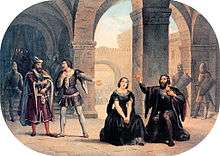 A scene from the Italian version of the opera (Lithograph by Roberto Focosi) | |
| Librettist | |
| Language | French |
| Based on | Original 1838 libretto for Donizetti's Le duc d'Albe |
| Premiere | 13 June 1855; Paris Opéra |
Today the opera is performed both in the original French and (rather more frequently) in its post-1861 Italian version as I vespri siciliani. The story is based on a historical event, the Sicilian Vespers of 1282, using material drawn from the medieval Sicilian tract Lu rebellamentu di Sichilia.[1]
Composition history
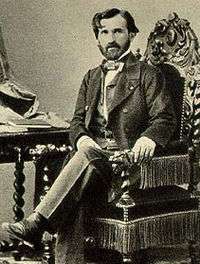
After Verdi's first grand opera for the Paris Opéra—that being his adaptation of I Lombardi in 1847 given under the title of Jérusalem - the composer had wanted to write a completely new grand opera for the company, the appeal being the same as that which influenced all Italian composers of the day: the challenges of a form different from that of their homeland and the ability to appeal to an audience which welcomed novelty.[2]
Verdi began discussions with the Opéra but negotiations were stalled by the 1848 revolutions and the composer broke them off for a period of time. It was not until February 1852 (while Il trovatore was still being prepared) that he returned to Paris and entered into a contract to write an opera, the libretto to be prepared by Scribe, who was given a deadline for a "treatment" to be delivered on 30 June 1853[2] with rehearsals to begin in mid-1854 and the opera staged in November/December of that year. Verdi was guaranteed the choice of suitable artists as well as forty performances in the ten months following the premiere.[2]
In July 1852, Verdi had written to Scribe outlining his hopes:
- I should like, I need a subject that is grandiose, impassioned and original; a mise-en-scene that is imposing and overwhelming. I have consistently in view so many of those magnificent scene to be found in your poems ... Indeed, these scenes are miracles! But you work them so often that I hope you will work one for me.[3]
When Scribe missed his July 1853 deadline, Verdi went to Paris to negotiate directly and it was then that the librettist proposed a solution, using a revised version of the libretto for Le duc d'Albe,[4] one which had been written about 20 years before at the height of the French grand opera tradition and which had previously been offered to Halévy (who refused it) and to Donizetti (who partly set it to music in 1839 under the original title).[5] Verdi raised many objections, many of these being outlined in a letter from Scribe to Duveyrier of December 1853.[6] They included a change of location, of characters' names, certain specific situations (there being no beer halls in Sicily, for example), plus a demand for a "standard" fifth act to make it equivalent to Meyerbeer's Les Huguenots or Le Prophète.
However, this "meant that Verdi was writing his first (original) opéra at a point at which the genre was in a state of flux".[5] Musicologist Julian Budden adds: "In opting for the grandest possible scale, Verdi was running against the current of fashion" (which he notes had significantly shifted in the months and years following the 1848 uprising, so that the country was now firmly in the epoch of Napoleon III, meaning "that the social foundation on which [grand opera] rested was now withdrawn").[7]
Verdi spent 1854 forcing Scribe to make revisions while writing the music, "complaining about the sheer length demanded by audiences at the Opéra".[4] Overall, it was a frustrating time for the composer, especially in dealing with Scribe's 5th act. The librettist was unresponsive to Verdi's pleas for revisions, until finally, he was forced in late 1854 (with no premiere in sight and the mysterious disappearance from rehearsals of Sophie Cruvelli, who sang Hélène) to write to the Opera's director, Louis Crosnier: "To avoid the catastrophe that menaces us ... I see but one means and I do not hesitate to propose it: dissolution of the contract".[8] However, Verdi persevered and was present at the June 1855 premiere, by then having spent close to two years in Paris working on the opera.
Performance history
19th century
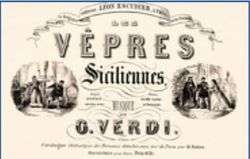
The first performance at the Paris Opéra on 13 June 1855 was received to great acclaim. La Presse noted: "Verdi's music has conformed to the procedure invented by French genius without losing anything of its Italian ardour.[9]
Hector Berlioz wrote: "In Les vêpres the penetrating intensity of the melodic expressiveness, the sumptuous, wise variety of the instrumentation, the vastness and poetic sonority of the concerted pieces, the hot colour that shines throughout ... communicate to this opera an imprint of grandeur, a species of sovereign majesty more distinguishable than in this composer's earlier products.[10]
Budden notes that "the critics found much to admire in the new opera. ... Adolphe Adam declared that Les vêpres had converted him to Verdi's music",[11] but Verdi himself, in a letter of late June, notes that three Italian writers were the most critical".[12]
However, its success was not long-lasting. Because the original version never entered the established repertory, performances "limped along"[5] until Verdi attempted to aid its revival at the Paris Opéra on 6 July 1863 by revising some of the roles for selected singers. However, after a few performances, the opera disappeared and was replaced by the French version of Il trovatore, Le trouvère. Except for this one revival in Paris in 1863, "it vanished from the Parisian stage altogether" [13]
20th century and beyond
After a long period of relative neglect, the opera in its original French version has begun to appear onstage more regularly in the 21st century. A production was mounted at the Bastille Opera in 2003 and a 2010 production by the Netherlands Opera. In May 2011 French versions were presented at the Grand Théâtre de Genève and at the Teatro San Carlo in Naples and, in February 2013, the ABAO company in Bilbao presented the opera.[14]
Other presentations have included stagings by Frankfurt Opera [15] in 2013 and Bavarian State Opera in 2018.[16]
The Royal Opera House Covent Garden's staging of the full version for the first time in its history (minus the ballet) in October/November 2013 drew a variety of critical responses. [17][18] [19]
Verdi's Italian-language version

An Italian libretto was quickly prepared under Verdi's supervision by the poet Ettore Caimi. The composer was aware that in Italy at that time, it would have been impossible to place the story in Sicily, as he notes to his publisher Giulio Ricordi in April 1855: "I shall ... (change) the subject so as to render it acceptable for Italian theatres".[20] Based on Scribe's suggestions for changing the location - "I suggested that the Duke of Alba should just pack his bags once more and move to Lisbon"[21] - it became Portugal in 1640 while under Spanish control. Therefore, the title was changed to Giovanna de Guzman. Overall, Verdi was not happy with the translation, which Budden regards as "one of the worst ever perpetrated.[22] However, some improvements were made when the opera reverted to its translated Italian title after 1861.
After 1861, in the post-unification era, the opera reverted to its translated Italian title, I vespri siciliani[13] and it is sometimes performed under that title and in that version today.
.jpg)
Marc Bonnehée
Roles
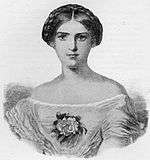
Sophie Cruvelli
| Role: |
Voice type | Premiere Cast, 13 June 1855[23] (Conductor: Narcisse Girard) |
|---|---|---|
| Guy de Montfort, Governor of Sicily under Charles d'Anjou, King of Naples | baritone | Marc Bonnehée |
| Le Sire de Béthune, a French officer | bass | Théodore-Jean-Joseph Coulon |
| Le Comte de Vaudemont, a French officer | bass | Jacques-Alfred Guignot |
| Henri, a young Sicilian | tenor | Louis Guéymard |
| Jean Procida, a Sicilian doctor | bass | Louis-Henri Obin |
| La Duchesse Hélène, sister of Duke Frederick of Austria | soprano | Sophie Cruvelli |
| Ninette, her maid | contralto | Clarisse-Françoise Sannier |
| Daniéli, her servant | tenor | Jean-Jacques Boulo |
| Thibault, a French soldier | tenor | M. Aimes |
| Robert, a French soldier | baritone | Mécène Marié de l'Isle |
| Mainfroid, a Sicilian, adherent of Procida | tenor | Joseph Koenig |
Synopsis
- Place: Palermo, Italy
- Time: 1282

Prior to the events of the opera, Procida, a leading Sicilian patriot, was wounded by French troops during their invasion of Sicily, and was forced into exile. Montfort, leader of the French troops, raped a Sicilian woman who later gave birth to a son, Henri. Montfort became governor of Sicily, while the Sicilian woman brought up her son to hate him, without revealing to Henri that Montfort was his father.
Act 1
Palermo's main square
Thibault, Robert and other French soldiers have gathered in front of the Governor's palace. As they offer a toast to their homeland, they are observed by the local Sicilians, unhappy with the occupation.
Hélène, who is being held hostage by the French governor, Montfort, enters dressed in mourning for her brother, Duke Frédéric of Austria, who had been executed by the French exactly a year before and whose death remains unavenged. Somewhat drunk, Robert, a French soldier of low rank, demands that she sing and she agrees. Her song about the prayers of seamen (Viens à nous, Dieu tutélaire – "Pray, O mighty God, calm with thy smile both sky and sea") and God's reply of "let dangers be scorned" ends with a rallying-cry (Courage!… du courage!) to the Sicilians to rebel against the occupiers. When the governor enters, the crowd calms down. Henri, just released from prison, assures Hélène how deeply he despises the governor. Overhearing this, Montfort orders Hélène to leave and then, alone with Henri, offers him a powerful position with his men as long as he stays away from Hélène. He refuses, and immediately follows Hélène into the palace.
Act 2
Beside the sea
Procida lands on the shore from a small fishing boat. It is clear that he is returning from exile and he expresses his joy at returning to his native land and city (Et toi, Palerme – "O thou Palermo, adored land…"). He is surrounded by Mainfroid and other companions and he quickly orders his men to bring Hélène and Henri to him (Dans l'ombre et le silence – "In darkness and in silence"). The three make plans for an uprising during the impending festivities leading to the marriages of a group of young people. After Procida leaves, Hélène asks Henri what reward he seeks. Swearing that he will avenge her brother's death, he asks for nothing but her love.
Béthune arrives with an invitation from Montfort to attend a ball. Henri refuses and is arrested and dragged off. Led by Robert, a group of French soldiers arrive and Procida returns and sees that it is too late to save Henri, since the young people have come into the square and have begun to dance. As the dance becomes more lively, Robert signals to his men, who seize many of the young women, dragging them off in spite of the protests of the young Sicilian men. The dejected young men witness a passing boat filled with French nobles and Sicilian women, all bound for the ball. Procida and others determine to gain entrance to the ball and seek their revenge.
Act 3
Scene 1: Montfort's palace
Montfort reads a paper from the woman whom he abducted, which reveals that Henri is his son (Si, m'abboriva ed a ragion! – "Yes, she despised me, and rightly!"). Béthune tells him that Henri has been brought by force, but Montfort exalts in the fact that his son is close by (Au sein de la puissance – "Given over to riches, surrounded by honors, an immense, horrid void…"). The two men confront one another and Henri is somewhat puzzled by the way he is being treated. Finally, Montfort reveals the letter written by Henri's mother. Taken aback but still defiant, Henri insults his father who reacts in anger as the younger man rushes out: "Fatal word!, Mortal insult! The joy has vanished ...".
Scene 2: A ball at Montfort's palace
When Montfort enters, he gives the signal for the ballet to begin.[24] In the crowd, but disguised, are Hélène, Henri, and Procida. Henri is surprised when the two reveal themselves and they declare that their purpose is to save the young man. However, he is disturbed to hear that they intend to kill Montfort and when the father approaches the son, there is a hint of warning given. As approaching assassins close in, Henri leaps in front of his father just as Hélène approaches. The Sicilians are horrified to see that Henri is being spared as the ensemble contemplates the situation. Hélène, Procida, Daniéli and the Sicilians curse Henri as they are dragged away, while he wants to follow, but is restrained by Montfort.
Act 4
A prison
Henri arrives at the prison gate and, on Montfort's orders, waits to be admitted. He contemplates the situation that his friends are in (O jour de peine – Day of weeping, of fierce sorrow!"). Hélène is brought out and confronts him. Finally, he admits that Montfort is his father and she begins to be willing to sympathise (Henri! Ah, parli a un core… – "Henri! Ah, you speak to a heart already prepared to forgive") Not seeing Henri, Procida approaches Hélène and reveals a letter telling him of awaiting freedom. But Montfort arrives and orders a priest and the execution of the prisoners while Procida is amazed to discover the truth of Henri's situation. Henri begs for mercy for his friends and Montfort confronts him with one thing: Dimmi sol, di’ “Mio padre” – "Say to me only, say “My father” ...". Henri says nothing as the executioner appears and the couple are led away, followed by Henri. Montfort steps in to prevent him from joining them. As Hélène is led towards the executioner, Montfort steps in and announces a pardon for the Sicilians. Furthermore, he agrees to the marriage of Hélène and Henri and announces to the crowd: "I find a son again!". There is general rejoicing.
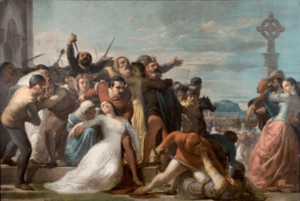
Act 5
The gardens of Montfort's palace
As knights and maidens gather, Hélène gives thanks to all (Merci, jeunes amies – "Thank you, beloved friends"). Henri arrives, exclaiming his joy (La brise souffle au loin – "The breeze hovers about…"). He leaves to find his father, but Procida arrives, announcing a plan to outwit his enemies with their massacre to take place at the foot of the altar after the vows have been said. She is torn, the more so following Henri's return, between her love and her duty (Sorte fatal! Oh, fier cimento! – "Fatal destiny! Oh, fierce conflict!"). Finally, she can go no further and she tells Henri that they cannot be married. Both men are furious with her for her seeming betrayal. Then Montfort arrives, takes the couple's hands, joins them together, and pronounces them married as the bells begin to ring. This is the signal for the Sicilians to rush in and hurl themselves upon Montfort and the French.
Music
In summing the effect of the libretto as "a competent framework for an opera of effects, of spectacle and theatrical surprise, and Verdi ended by accepting it as such", musicologist Julian Budden then notes two of its aspects which appear distinctive and which are visible in the music. Firstly, "he used it as a basis for a new, more ample, more rhythmically complex style of melody. Here the model of Meyerbeer was important ... Secondly, he seized the opportunity of solving a problem which had eluded him in a somewhat similar work, La battaglia di Legnano; namely that of reconciling the private and public emotions of the main characters. ... .the problem being overcome by means of a more varied musical language."[25]
Musicologist Roger Parker, writing in Grove in 1992, offers a somewhat different point of view in explaining that the sheer length and scale of this opera (as well as others in the grand opera tradition) find themselves being rarely staged by modern opera houses (since 1992 this situation has changed, see performance history section above). Parker states "with very few exceptions, its main lyrical numbers lack the melodic immediacy of the trio of Italian operas (Rigoletto, Il trovatore and La traviata) that immediately preceded it."[26] However, he does go on to say that Les Vêpres "marks a decisive turn away from the language of the middle-period Italian operas and the emergence of many stylistic features we associate with the later Verdi."[4]
Coda
Given the frustrations which Verdi encountered in the two-year-long preparation of the opera and the several expressions of these frustrations in letters to Giuseppina Strepponi (with whom he was having a relationship which began about 1847), writer Irving Kolodin in his essay for the RCA recording, hits on a solution which Strepponi herself had provided:
- In your position I wouldn't tie myself in any way for the present. I should look for a libretto I liked and set it to music without any engagement and in my own time.[27](Italics in the original).
Kolodin comments: "It was, of course, the principle by which Verdi's later career was guided when he had the land and the position he craved and the security that went with them and a wise wife."[28]
Recordings
| Year | Cast (Hélène, Henri, Montfort, Procida) |
Conductor, Opera House and Orchestra |
Label [14] |
|---|---|---|---|
| 1951 | Maud Cunitz Helge Rosvaenge Heinrich Schlusnus Otto von Rohr | Kurt Schröder, Chorus and Orchestra of Hessischer Rundfunk, Chorus Director: Edmund von Michnay | Deutsche Grammophon Cat: LPEM 19 244146 |
| 1969 | Jacqueline Brumaire Jean Bonhomme Neilson Taylor Stafford Dean | Mario Rossi (Ashley Lawrence for ballet), BBC Concert Orchestra, BBC Chorus | Audio CD: Opera Rara Cat: ORCV303 |
| 2003 | Nelly Miricioiu, Marcello Giordani, Anthony Michaels-Moore, Ferruccio Furlanetto |
James Conlon, Orchestra and Chorus of the Paris Opera, (Recording...appears to be of the performance on 27 June at the Bastille Opera) |
Audio CD: Celestial Audio, Cat: CA 452 |
| 2010 | Barbara Haveman Burkhard Fritz Alejandro Marco-Buhrmester Balint Szabo |
Paolo Carignani, Netherlands Philharmonic Orchestra and Chorus of the Netherlands Opera |
DVD: Opus Arte Cat: 1060D |
| 2013 | Lianna Haroutounian Bryan Hymel Michael Volle Erwin Schrott |
Antonio Pappano, Orchestra and Chorus of the Royal Opera |
DVD: Opus Arte |
References
Notes
- Backman, p. 6
- Budden, p. 169
- Verdi to Scribe, 27 July 1852 in Budden, pp. 171–172
- Parker, pp. 924–925
- Everist, p. 12
- Budden, pp. 173–174
- Budden, pp. 170–171
- Verdi to Crosnier, in Kolodin, p. 7
- La Presse, quoted in Kolodin, p. 8
- Quoted in Kolodin, p. 8
- Budden, p. 187
- Verdi to Clara Maffei, in Budden, p. 187.
- Budden, pp. 238–240
- Recordings of the opera from operadis-opera-discography.org.uk
- Operabase.com performance database
- Maier, Maximilian. "Verdi Mit Techno-Ballett". BR Klassik De. br-klassik.de. Missing or empty
|url=(help) - Andrew Clements, "Les vêpres siciliennes - review", The Guardian (London), 18 October 2013
- Rupert Christiansen, "Les Vêpres Siciliennes, Royal Opera, Royal Opera House, review", Telegraph (London), 18 October 2013
- "Les vêpres siciliennes at ROH", 23 October 2013 on capricciomusic.blogspot.co.uk. Retrieved 11 December 2013
- Letter from Verdi to Ricordi, 29 April 1855, quoted in Budden, p. 238
- Scribe to unknown, quoted in Budden, p. 238
- "I now know what it means to translate and I feel sympathy for all bad translations that are around because it is impossible to make a good one", Verdi to Ricordi, 6 June 1865 in Budden, p.238
- List of singers taken from Budden, p.168
- Willson 2013, p. 47, notes that Verdi was willing to comply with the traditions of Parisian Grand opera although "the precise position of [the] dance episodes was not stipulated", but the location favoured by the Opera's management and most composers was midway through the grand opera's long-haul journey, the second or third act (or both).
- Budden, p. 188
- Parker, p. 927
- Strepponi to Verdi, 17 January 1853, in Kolodin, p. 8.
- Kolodin, p. 8
Cited sources
- Backman, Clifford R. (2002), The Decline and Fall of Medieval Sicily: Politics, Religion, and Economy in the Reign of Frederick III, 1296–1337 Cambridge: Cambridge University Press.
- Budden, Julian (1984), The Operas of Verdi, Volume 2: From Il Trovatore to La Forza del destino. London: Cassell. ISBN 978-0-19-520068-3 (hardcover) ISBN 978-0-19-520450-6 (paperback).
- Everist, Mark (2004), "Killing a Bull" and the Pleasures of History: Verdi's Les Vêpres Siciliennes " in the booklet accompanying the Opera Rara recording of Les Vêpres Siciliennes
- Kimbell, David (2001), in Holden, Amanda (Ed.), 2001, The New Penguin Opera Guide, New York: Penguin Putnam. ISBN 0-14-029312-4
- Kolodin, Irving (1974), "I vespri Siciliani: How It Came to Be - What it Came to Be". Essay in booklet accompanying the (Italian language) Levine RCA recording, BMG.
- Parker, Roger (1998), "Vêpres siciliennes, Les", in Stanley Sadie, (Ed.), The New Grove Dictionary of Opera, Vol. Four. London: Macmillan Publishers, Inc. ISBN 0-333-73432-7 ISBN 1-56159-228-5
- Willson, Flora (2013), "Bear of Busetto, Lord of the Dance", Les Vêpres siciliennes, Royal Opera House, Covent Garden. Program book for 2013 production. pp. 44 to 49.
Other sources
- Baldini, Gabriele, (trans. Roger Parker) (1980), The Story of Giuseppe Verdi: Oberto to Un Ballo in Maschera. Cambridge, et al: Cambridge University Press. ISBN 0-521-29712-5
- Chusid, Martin, (Ed.) (1997), Verdi’s Middle Period, 1849 to 1859, Chicago and London: University of Chicago Press. ISBN 0-226-10658-6 ISBN 0-226-10659-4
- De Van, Gilles (trans. Gilda Roberts) (1998), Verdi's Theater: Creating Drama Through Music. Chicago & London: University of Chicago Press. ISBN 0-226-14369-4 (hardback), ISBN 0-226-14370-8
- Hibberd, Sarah (2013), "The Creation of Les Vêpres siciliennes, Royal Opera House, Covent Garden. Program book for 2013 production. pp. 11 to 17.
- Gossett, Philip (2006), Divas and Scholar: Performing Italian Opera, Chicago: University of Chicago Press. ISBN 0-226-30482-5
- Osborne, Charles (1969), The Complete Opera of Verdi, New York: Da Capo Press, Inc. ISBN 0-306-80072-1
- Martin, George, Verdi: His Music, Life and Times (1983), New York: Dodd, Mead and Company. ISBN 0-396-08196-7
- Osborne, Charles (1969), The Complete Opera of Verdi, New York: Da Capo Press, Inc. ISBN 0-306-80072-1
- Parker, Roger (2007), The New Grove Guide to Verdi and His Operas, Oxford & New York: Oxford University Press. ISBN 978-0-19-531314-7
- Phillips-Matz, Mary Jane (1993), Verdi: A Biography, London & New York: Oxford University Press. ISBN 0-19-313204-4
- Pistone, Danièle (1995), Nineteenth-Century Italian Opera: From Rossini to Puccini, Portland, OR: Amadeus Press. ISBN 0-931340-82-9
- Toye, Francis (1931), Giuseppe Verdi: His Life and Works, New York: Knopf.
- Walker, Frank (1962), The Man Verdi, New York: Knopf, 1962, Chicago: University of Chicago Press. ISBN 0-226-87132-0
- Warrack, John and West, Ewan, The Oxford Dictionary of Opera New York: OUP: 1992 ISBN 0-19-869164-5
- Werfel, Franz and Stefan, Paul (1973), Verdi: The Man and His Letters, New York, Vienna House. ISBN 0-8443-0088-8
- White, Jonathan (2013), "Problems of Historical Licence", Les Vêpres siciliennes, Royal Opera House, Covent Garden. Program book for 2013 production. pp. 19 to 25.
- Wintle, Christopher (2013), "Fortunate Untruth", Les Vêpres siciliennes, Royal Opera House, Covent Garden. Program book for 2013 production. pp. 36 to 43.
External links
- Les vêpres siciliennes: Scores at the International Music Score Library Project (IMSLP)
- Synopsis, libretto, giuseppeverdi.it (in Italian)
- Synopsis from Naxos Records